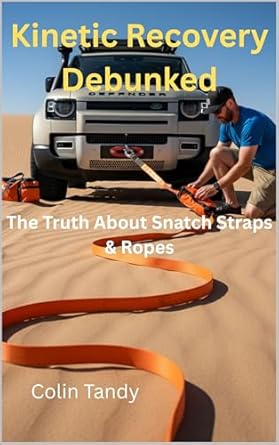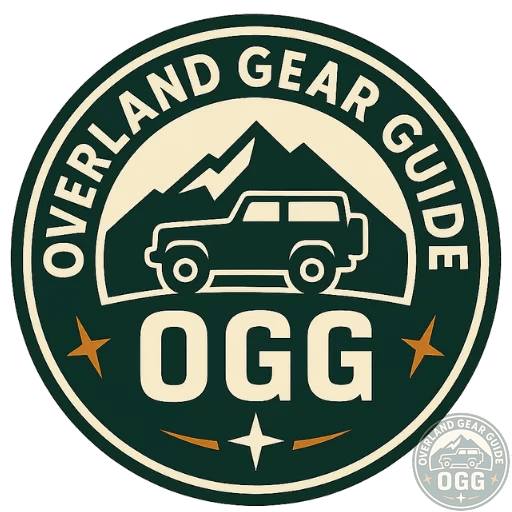Kinetic Recovery Debunked — The Truth About Snatch Straps & Ropes

Our verdict: a clear, myth-free primer on kinetic recoveries for real overlanders. It demystifies the physics, shows how ratings translate on the trail, and teaches safer, repeatable pulls.

Kinetic Recovery Debunked (Kindle eBook)
Plain-English guide to snatch straps & kinetic ropes — sizing, technique, and risk management by Colin Tandy.
What’s inside (chapter-by-chapter highlights)
1) Fundamentals & Physics
Explains elastic energy, work over distance, and why speed, mass, stretch and run-up length control peak force. Shows how longer work distance and progressive throttle lower shock loads.
- Contact patch & traction limits during a kinetic pull
- Why short, violent run-ups spike load into anchors
2) Gear & Ratings (Labels Decoded)
Breaks down WLL vs MBS, safe margins, and stretch % (aim ~15–30% for kinetic work). Clarifies strap vs rope behaviour, soft shackles, bridles and proper tree protection.
- System matching: strap/rope ↔ shackles ↔ recovery points
- Inspection & retirement cues (glazing, cuts, contamination)
3) Technique & Communication
Stages a full recovery: rig assessment, line choice, spotter roles, “progressive energy” pulls and when to switch to a controlled tow or winch.
- Clear hand signals + radio brevity
- Align straight; manage slack consistently
4) Scenarios & Failure Modes
Applies the rules to sand bogs, mud suction and rock shelves. Analyses common failures (anchor tear-out, side-loads, short run-up spikes) and prevention.
- How to reduce suction before pulling
- When rim/tyre conditions make snatch a bad choice
Top myths the book dismantles
- “More speed = more success.” Bigger run-ups create load spikes. Do more work over distance with smooth, progressive pulls.
- “Higher-rated strap = always safer.” Mismatch with weaker anchors/shackles moves failure elsewhere. Match the whole system with margin.
- “All stretch is the same.” Strap vs rope elongation curves differ; choose reputable kit and the right stretch band for kinetic work.
- “If it didn’t break, it was fine.” Heat, glazing and over-cycling degrade strength. Inspect and retire proactively.
Field rules (simple, memorable)
| Rule | Why it matters |
|---|---|
| Progressive pulls, small steps | Build energy gradually; avoid shock peaks into anchors and chassis. |
| Do work over distance | Use enough strap length and alignment to lower peak force for the same “stuckness.” |
| Match the system | Strap/rope, shackles and recovery points should share compatible strength & safety factors. |
| Know when to switch | If angles are ugly, anchors unknown, or space is tight—choose a controlled tow or winch. |
| Inspect every cycle | Glaze, cuts, knots, contamination or heat = retire or downgrade to non-kinetic uses. |
Scenario walkthroughs (how the book applies it)
Sand bog (crest approach)
Clear path, reduce suction with boards/shovel, align straight, take a short slack, and use a low-energy first pull. Add distance or slight speed only if needed.
Mud suction (rut exit)
Break suction first (dig/boards), lift with slight vertical component if possible via angles/bridle. Avoid wheel hop; short violent yanks spike loads.
Rock shelf (hung diffs)
If tyres bind and the angle side-loads gear, swap to winch or a controlled tow. Kinetic pulls excel at breaking suction, not levering heavy hang-ups.
What we liked
- Trail-first explanations with practical decision rules.
- Clear gear-matching guidance (WLL vs MBS, stretch %, soft shackles, tree protection).
- Scenario analysis that translates lab ideas into field habits.
Could be better
- A one-page printable pre-pull checklist would be a great glovebox add-on.
Pre-pull safety checklist
- Rated, compatible recovery points only (never tow balls).
- Clear the recoil zone; bystanders ≥ 2× strap length away.
- Start low energy: short, slow pull; add speed/distance only as needed.
- Keep lines straight; avoid side-loading. Use bridles or trees correctly.
- Spikes, tyre bark, or hop? Stop and reduce energy or change method.
Related skills & gear
Disclosure: Some links are affiliate links. If you buy through them, we may earn a small commission at no extra cost to you.

